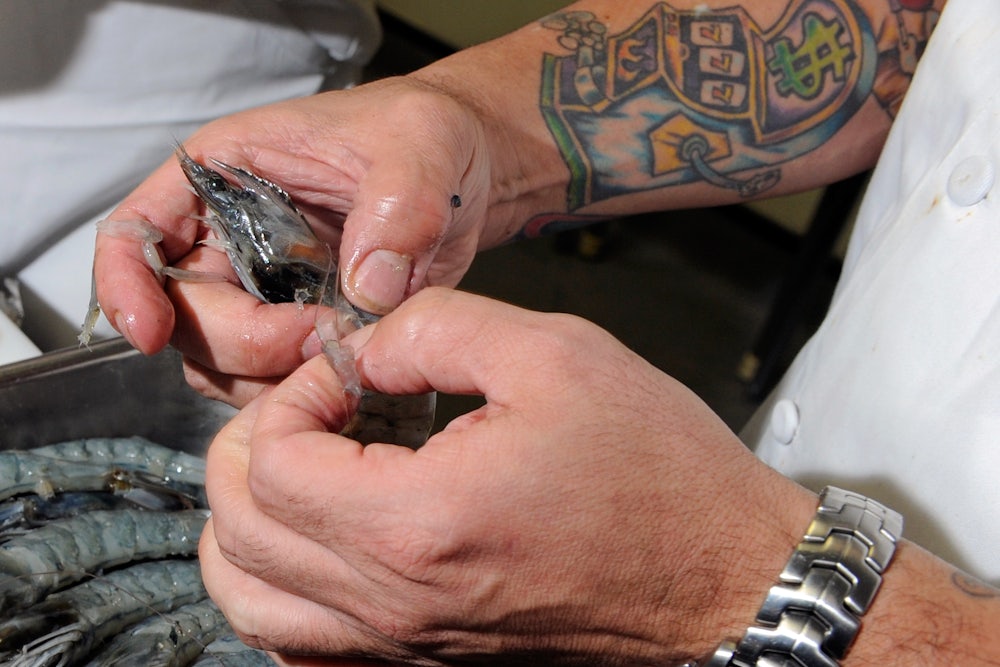In 2015, a bombshell story from the Associated Press reported that Burmese migrants, including children, were spending upwards of 16 hours per day peeling shrimp in Thailand, helping to sustain the country as one of the biggest providers of the crustacean in the world. Five years later, it looks like little has changed, with Human Rights Watch calling the country’s adjustments to the industry “cosmetic” in early 2018. Thailand remains the world’s largest exporter of shrimp. The human cost of the world’s obsession with this specific seafood—it accounts for a full quarter of the seafood consumption in the U.S., and it’s estimated that the average American eats four pounds per year—hasn’t changed either eating or production behavior. And amazingly, there is yet another ethical issue to consider with shrimp and prawns: the greenhouse gas emissions of farming them.
According to Our World in Data, farmed prawns (“prawn” and “shrimp” are commonly used interchangeably in the culinary and agricultural world despite technically being two different types of animals) follow only beef, coffee, and chocolate in non-methane greenhouse gas emissions. Yet they are rarely discussed in the same manner as beef, which is broadly acknowledged in food media and by environmentalists as a food to be consumed rarely and consciously. Seafood generally has a health and sustainability halo because it does, when wild-caught, require less resources for its production. But farmed seafood has been outpacing wild catch in recent years, making up the majority of the global market starting in 2014.
Farmed prawns now account for 55 percent of global shrimp production, which generally takes place in the tropical and subtropical areas of Asia and South America. Jennifer Kaplan, who teaches food systems at the Culinary Institute of America in St. Helena California, said the reason for those high emissions has to do with the destruction of carbon-rich mangroves and the deforestation that occurs when clearing out space for farming. Cutting down trees both removes a natural means of capturing greenhouse gases and also releases what they’ve stored. “That’s why those farmed prawns have such a big footprint,” she told me.
The detrimental impact of shrimp farming on humans and the environment has been reported for quite a long time without a widespread response. In 2003, the Environmental Justice Foundation issued a report tracking how shrimp farms have blocked native people from accessing their own coast and its resources, and how the loss of mangroves increases the risks from tidal waves and cyclones for rural communities. A 2017 publication on the relationship between mangroves and shrimp cultivation noted that some shrimp-producing countries have seen an uptick in disease outbreaks owing to the environmental destruction caused by these aquaculture operations.
The World Wildlife Federation has stated that aquaculture could be a sustainable means of raising seafood, if regulations are in place to keep environmental destruction in check and diversify the type of products raised. But right now, 80 percent of farmed shrimp consist of only two species; the lack of genetic diversity has the potential to breed disease and wipe out the entire crop. Government regulation and oversight that promotes biodiversity, caps production, ensures sustainable farm construction, and creates guidelines for international trade could ensure that the shrimp served at a restaurant or sold at the market were neither environmentally destructive nor cultivated using exploited labor.
For some people in the food world, the cumulative effect of the bad news about shrimp has led to a silent boycott. While better global policy agreements around aquaculture could render that unnecessary, currently any imported shrimp consumed in North America is suspect. Karon Liu, a culture reporter and recipe developer at The Toronto Star, made a decision not to use shrimp in published recipes after reading the Associated Press reporting from 2015.
“If I do want to cook with shrimp at home, I’ll go to a really reputable fishmonger in downtown Toronto that uses wild-caught Gulf shrimp,” he told me. But he can’t encourage nor ensure that his readers do the same, and so he’s simply avoided it professionally. No reader has yet to complain.
Kaplan encourages those who would like to consume and serve sustainably caught or raised shrimp to look into the James Beard Foundation’s Smart Catch program, which works directly with seafood suppliers around the U.S. to promote the use of diverse and traceable options at restaurants. The Monterey Bay Aquarium’s Seafood Watch also has a searchable database of all seafood, with specific recommendations ranked from “best” to “avoid” that can help when shopping for home cooking. Their simplest advice is to opt always for U.S. farmed options, as the environmental regulations are tighter than they are in other parts of the world. But with over 90 percent of the shrimp available in the U.S. being imported, it can be difficult and pricey to find these higher quality options.
“The reality is, every time we make a food choice, we engage in a process of trade-offs,” said Kaplan. “Being clear about those trade-offs is probably one of the things people can do to stay sane.” She encourages a three-layer approach when buying food: taking into consideration organic farming practices, how many miles the food has traveled in order to get to the market, and transparent sustainability efforts. “I don’t always get all three in one,” she admitted, but being conscious of these matters, especially with regards to high-impact foods like shrimp, will lead to more environmentally friendly choices.
In practice, this probably means leaving the plastic-ring shrimp cocktail at the supermarket rather than adding it to the party spread, or ordering the vegetarian option when confronted with the choice between shrimp and tofu. The planet’s mangroves will breathe a sigh of relief.
